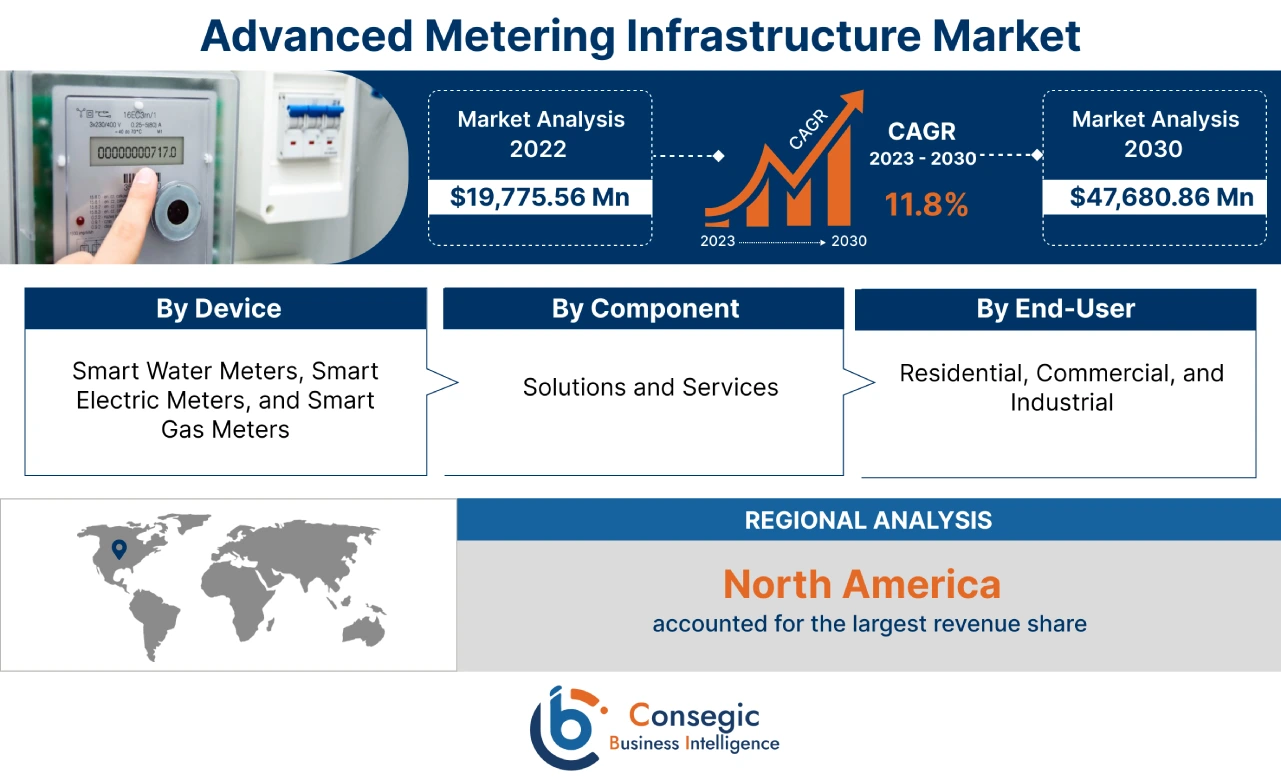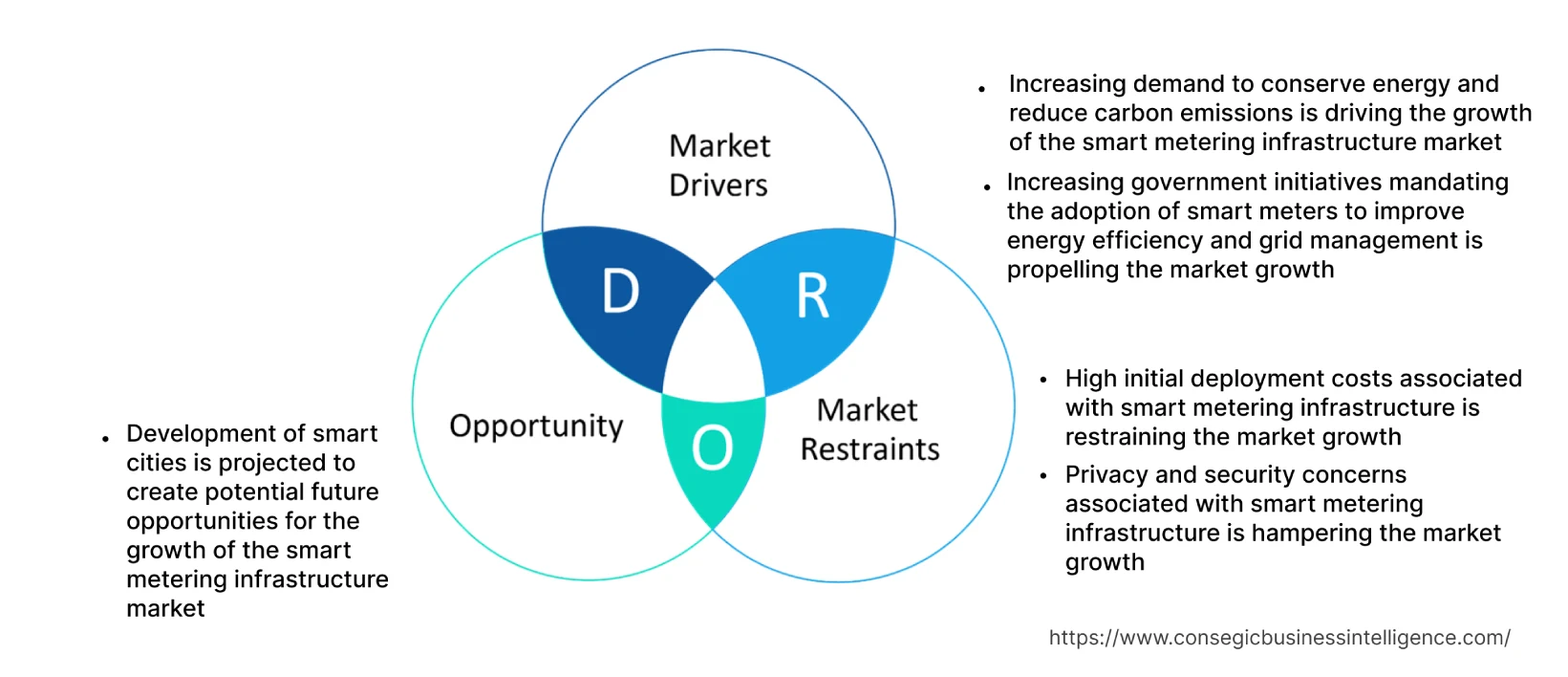Advanced Metering Infrastructure Market Size :
Advanced Metering Infrastructure Market size is estimated to reach over USD 47,680.86 Million by 2030 from a value of USD 19,775.56 Million in 2022, growing at a CAGR of 11.8% from 2023 to 2030.
Advanced Metering Infrastructure Market Scope & Overview:
Advanced Metering Infrastructure (AMI) refers to a comprehensive network of smart meters, communication systems, and data management technologies that enable two-way communication between utility companies and consumers. AMI facilitates the collection, measurement, and analysis of energy consumption data in real time, allowing for more accurate billing, improved load management, and enhanced energy efficiency. Additionally, based on the analysis, by providing insights into energy usage patterns, AMI enables utilities to optimize the operations, identify and respond to outages, and offer consumers valuable information to make informed decisions about energy consumption.
Advanced Metering Infrastructure Market Insights :
Advanced Metering Infrastructure Market Dynamics - (DRO) :
Key Drivers :
Increasing demand to conserve energy and reduce carbon emissions is driving the expansion of the smart metering infrastructure market
Smart meters provide consumers with real-time information about energy consumption, enabling users to reduce energy waste, optimize energy usage, and lower carbon footprint. In addition, smart meters enable requirement response programs, allowing consumers to reduce or shift energy usage during peak demand periods. Moreover, by sending signals to consumers through smart meters, utilities incentivize load shifting and better manage electricity requirement. Consequently, based on the analysis, the ability of smart meters to avoid the need for additional power generation, reduce carbon emissions, and optimize the grid's efficiency is thus contributing significantly in driving the expansion of the market. For instance, in August 2021, Tata Power Delhi Distribution Limited and Siemens Limited partnered together for the deployment of smart metering technology in North Delhi. The implementation of smart metering infrastructure will help the users in real-time consumption monitoring and better energy usage management along with providing low power factor alerts.
Increasing government initiatives mandating the adoption of smart meters to improve energy efficiency and grid management is propelling the market expansion
Governments worldwide are implementing regulations that require utility companies to deploy smart meters to achieve energy efficiency and grid modernization goals. Additionally, governments are setting energy efficiency targets to reduce energy consumption and carbon emissions. Smart meters enable accurate measurement of energy usage, providing a foundation for energy management programs and initiatives. Moreover, smart meters play a crucial role in grid management and optimization, enabling utilities to monitor electricity requirement in real-time, identify peak usage periods, and balance supply and requirement more efficiently. In conclusion, as per the analysis, the aforementioned government initiatives result in a more stable grid, reduced transmission losses, and improved system performance, thus contributing notably in accelerating the market expansion. For instance, in June 2020, the United Kingdom government introduced new plans for the installation of smart meters in households to reduce energy bills and carbon emissions. The government plans to install smart meters in businesses and homes within 4 years and is expected to reduce carbon emissions by 45 million tonnes, hence contributing remarkably in fueling the advanced metering infrastructure market growth.
Key Restraints :
High initial deployment costs associated with smart metering infrastructure is restraining the market expansion
The initial investment required for deploying smart metering infrastructure is considerably high, hindering the trends of the market. Additionally, the cost of upgrading and replacing existing meters, implementing communication networks, and installing data management systems is also significantly high. Based on the analysis, the high upfront expenses limit the adoption of smart meters by small enterprises with limited financial resources, hence impeding the advanced metering infrastructure market trends.
Privacy and security concerns associated with smart metering infrastructure is hampering the market expansion
Smart meters collect granular energy consumption data, which is considered personally identifiable information (PII) and raises concerns regarding the storage and accession of data. Additionally, smart meters are vulnerable to unauthorized access with cybercriminals potentially manipulating meter readings, disrupting data transmission, or gaining unauthorized control over the metering system. Based on the analysis, implementing strong access controls, encryption, and intrusion detection systems is essential to prevent unauthorized access and maintain the integrity of the system, adding to additional upfront costs, and thus restraining the market trends.
Future Opportunities :
Development of smart cities is projected to create potential future opportunities for the growth of the smart metering infrastructure market
Smart cities aim to optimize energy consumption and reduce environmental impact. Smart metering infrastructure plays a crucial role in monitoring and managing energy usage at the city level. In addition, by deploying smart meters throughout the city, utilities and city administrators gather real-time energy consumption data, identify patterns, and implement energy efficiency measures. Moreover, smart cities integrate multiple energy systems including electricity, water, and transportation and smart metering infrastructure facilitates the seamless integration and coordination of such systems. For instance, smart meters monitor electric vehicle charging, enable dynamic pricing, and optimize energy usage across various sectors. Subsequently, the growth of smart cities necessitates an interconnected energy infrastructure, hence creating potential trends for the growth of the advanced metering infrastructure market opportunities.
Advanced Metering Infrastructure Market Report Insights :
| Report Attributes | Report Details |
| Study Timeline | 2017-2030 |
| Market Size in 2030 | USD 47,680.86 Million |
| CAGR (2023-2030) | 11.8% |
| By Device | Smart Water Meters, Smart Electric Meters, and Smart Gas Meters |
| By Component | Solutions and Services |
| By End-User | Residential, Commercial, and Industrial |
| By Region | North America, Europe, Asia-Pacific, Latin America, and Middle East & Africa |
| Key Players | Aclara Technologies LLC, Siemens AG, Cisco Systems, Inc., Cooper Industries, Elster Group GmbH, General Electric, Landis+Gyr Technology Inc., IntelliSmart Infrastructure Pvt. Ltd., International Business Machines Corporation, Itron, Inc., Schneider Electric SE, Sensus, Silver Spring Networks, Tieto Corporation, Trilliant, Inc., El Paso Electric |
| Geographies Covered | |
| North America | U.S. Canada Mexico |
| Europe | U.K. Germany France Spain Italy Russia Benelux Rest of Europe |
| APAC | China South Korea Japan India Australia ASEAN Rest of Asia-Pacific |
| Middle East and Africa | GCC Turkey South Africa Rest of MEA |
| LATAM | Brazil Argentina Chile Rest of LATAM |
| Report Coverage | Revenue Forecast, Competitive Landscape, Growth Factors, Restraint or Challenges, Opportunities, Environment & Regulatory Landscape, PESTLE Analysis, PORTER Analysis, Key Technology Landscape, Value Chain Analysis, Cost Analysis, and Regional Trends & Forecast |
Advanced Metering Infrastructure Market Segmental Analysis :
By Device :
The device segment is trifurcated into smart water meters, smart electric meters, and smart gas meters. Smart electric meters accounted for the largest market share in 2022 as smart electric meters play a crucial role in energy efficiency and grid optimization. The smart electric meters provide accurate and real-time data on electricity consumption, enabling utilities to identify patterns, monitor peak demand, and optimize energy distribution. Additionally, smart meters enable utilities to implement demand response programs effectively, allowing customers to adjust electricity usage during peak demand periods, to balance the grid and avoid power shortages. Consequently, the ability of smart electric meters to focus on energy efficiency and grid stability is contributing considerably in driving the expansion of the segment. For instance, in November 2022, Trilliant Holdings Inc. partnered with Manx Utilities for the installation of smart electricity meters for 8,000 customers across the Isle of Man. The aim of the partnership is to replace existing electricity meters with advanced metering infrastructure to reduce electricity consumption and save on energy costs for approximately 50,000 industrial, residential, and commercial customers.
Smart water meters are anticipated to witness the fastest CAGR in the advanced metering infrastructure market during the forecast period. The expansion of the market is attributed to the increasing global focus on water conservation and sustainable resource management, driving the adoption of smart water meters. In addition, smart water meters provide real-time data on water consumption, enabling utilities and consumers to identify leaks, monitor usage patterns, and implement water conservation measures. Moreover, smart water meters detect leaks and abnormalities in water usage, enabling proactive maintenance and reducing water loss, further contributing to market trends. Consequently, the need to modernize water infrastructure improve efficiency, and optimize water resource management is bolstering the advanced metering infrastructure market demand.
By Component :
The component segment is bifurcated into solutions and services. Solutions accounted for the largest market share in 2022 and comprise meter data management, meter data analytics, meter communication infrastructure, and advanced metering infrastructure security. Meter Data Management (MDM) holds the largest market share as MDM solutions provide utilities with a centralized platform to manage and process the vast amounts of data collected from smart meters. Additionally, meter data management handles data validation, storage, and integration with other utility systems namely billing and customer information systems. The ability to effectively manage and utilize metering data is crucial for utilities to optimize the operations and deliver accurate billing services.
Moreover, MDM solutions play a critical role in billing and revenue management by calculating accurate consumption data based on meter readings, facilitating complex tariff calculations, generating invoices, and managing billing cycles. In conclusion, MDM solutions streamline the billing process, reduce billing errors, and enable efficient revenue collection, hence contributing significantly in fueling the market trends. For instance, in May 2021, Itron, Inc. collaborated with Microsoft to offer highly scalable cloud-based advanced metering infrastructure solutions to users. The advanced solution is able to process 2.8 billion readings in less than three hours and provide billing determinants equal to a 10 million meter utility, hence contributing significantly in accelerating the market trends.
The services segment is anticipated to witness the fastest CAGR in the advanced metering infrastructure market during the forecast period. The installation and deployment of smart metering infrastructure involves complex processes, including physical installation of fiber optic cable assemblies, configuration, and network integration. Service providers offer specialized expertise and resources to ensure seamless deployment, efficient project management, and timely implementation. Additionally, smart metering infrastructure requires ongoing maintenance, monitoring, and support to ensure optimal performance. Service providers offer maintenance services to address issues namely firmware updates, meter calibration, and fault detection, and also provide support services, including troubleshooting, meter replacements, and customer assistance. Consequently, the aforementioned factors are responsible for accelerating the trend of the services segment during the forecast period.
By End-User :
The end-user segment is categorized into residential, commercial, and industrial. Residential sector accounted for the largest advanced metering infrastructure market share of 61.6% in 2022 as smart meters provide precise measurements of electricity, gas, and water consumption in residential properties. The smart meters ensure accurate billing based on actual usage, eliminating manual readings, and are calibrated precisely, thus benefitting the customers by providing more fair billing practices. Additionally, smart meters enable real-time monitoring of energy consumption in residential properties through online portals and mobile apps, allowing consumers to access energy usage data, view consumption patterns, and track costs. Moreover, the emergence of the Internet of Things (IoT) offers advanced grid-edge intelligence to support distribution system operators in maintaining an efficient and reliable grid, further increasing the adoption of smart meters in the residential sector. For instance, in November 2022, Landis+Gyr launched E360 residential electric meter and W270 and W370 smart water meters based on IoT technologies and 100% recyclable material. The electric meter provides ten times more accuracy and speed in comparison to traditional meters to maintain a reliable and efficient grid, hence contributing remarkably in propelling the trends of the residential sector.
The industrial sector is anticipated to witness the fastest CAGR in the advanced metering infrastructure market during the forecast period. The expansion is endorsed by the ability of industrial smart meters to monitor and manage energy consumption in real time by tracking energy usage patterns and identifying areas of high consumption. In addition, smart meters provide accurate data for energy audits, to monitor the electricity demand and identify peak usage periods. Moreover, smart meters equipped with power quality monitoring capabilities help industrial facilities track and assess the quality and stability of the electricity supply. The monitoring parameters include voltage fluctuations, harmonics, and power factors for detecting and rectifying power quality issues, reducing equipment downtime, optimizing performance, and ensuring reliable operations. In conclusion, the aforementioned factors are contributing notably in fueling the trends of industrial smart meters during the forecast period.
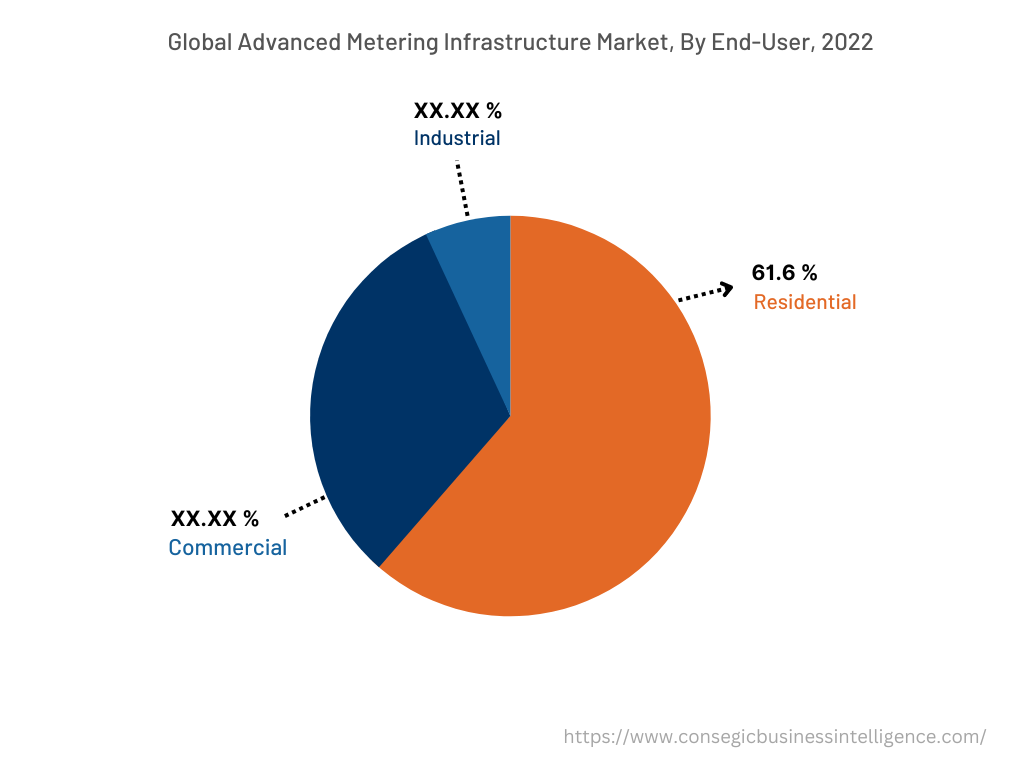
By Region :
The regional segment includes North America, Europe, Asia Pacific, Middle East and Africa, and Latin America.
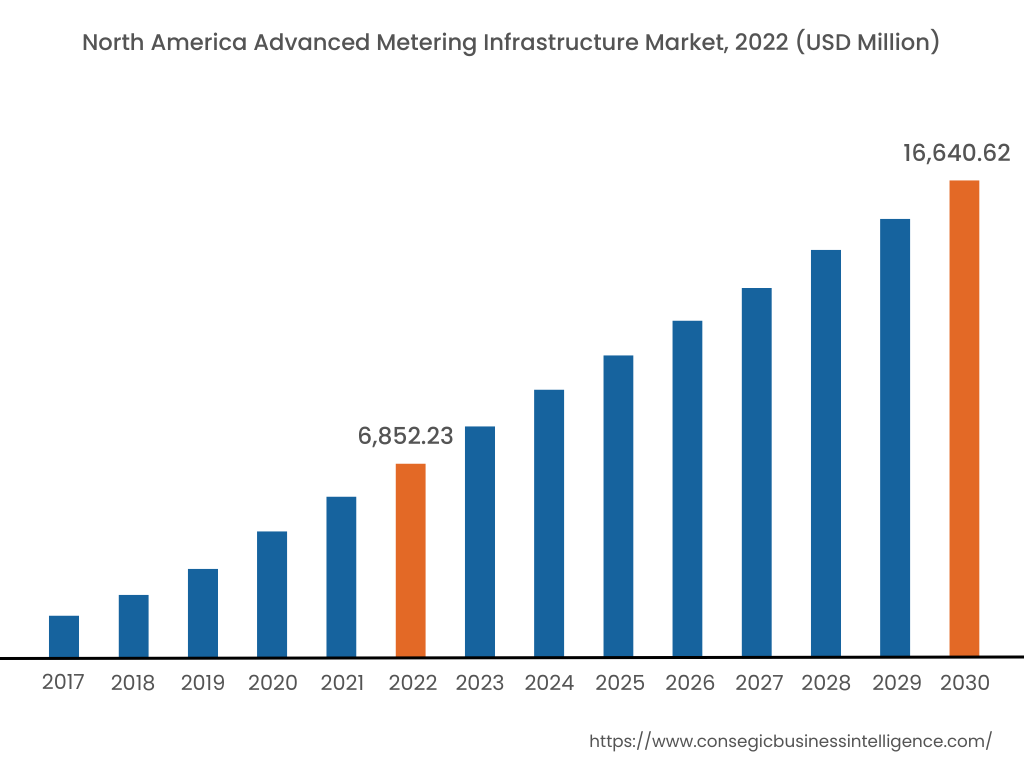
North America accounted for the largest revenue share in the year 2022 valued at USD 6,852.23 million and is predicted to reach USD 16,640.62 million in the advanced metering infrastructure market. In addition, in the region, the United States accounted for the maximum revenue share of 62.35% in the year 2022. North America is at the forefront of implementing regulatory policies that drive the adoption of smart metering infrastructure. In particular, the United States is witnessing significant regulatory support at the federal and state levels, mandating utilities to deploy smart meters for improved energy efficiency, grid modernization, and consumer benefits. Moreover, the aging infrastructure in North America, particularly in the electricity and water sectors, is creating a need for modernization and improved efficiency. Based on the advanced metering infrastructure market analysis, smart metering infrastructure offers a solution for utilities to upgrade the systems, enhance data collection, and optimize operations. Furthermore, the presence of key players in the region including Trilliant Holdings Inc., General Electric Company, and Emerson Electric Co. constantly applying innovations and strategic decisions to expand the market portfolio is also contributing to the market growth. For instance, in July 2022, Trilliant Holdings Inc. deployed more than 3.5 million smart meters in the Asia-Pacific region and also started its manufacturing in Malaysia.
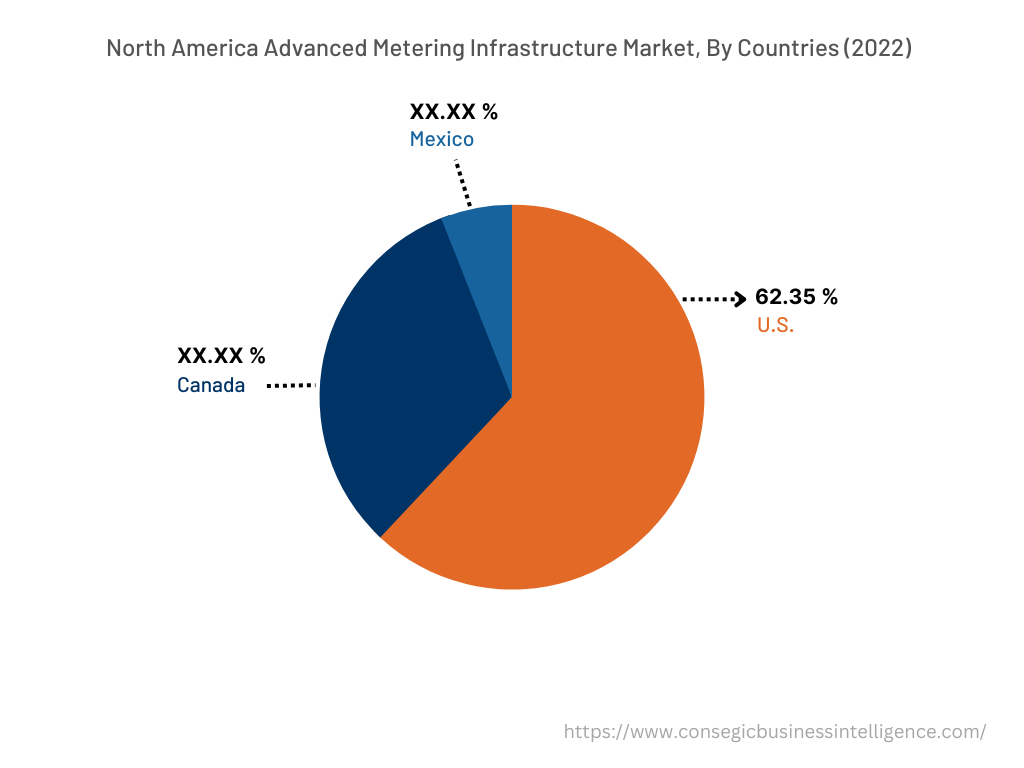
Asia Pacific is anticipated to witness the fastest CAGR of 12.2% owing to the significant investments in the development of smart cities. Smart metering infrastructure is a critical component of smart city initiatives, enabling efficient energy management, demand response, and sustainability practices. Additionally, the growing awareness of energy efficiency and the importance of sustainable practices among consumers, businesses, and governments in Asia Pacific is also propelling market growth. Smart metering infrastructure empowers consumers to monitor energy consumption, make informed decisions, and actively participate in energy-saving initiatives. Moreover, Asia Pacific is witnessing significant growth in renewable energy generation, including solar and wind power. Smart metering infrastructure plays a crucial role in integrating and managing distributed energy resources into the grid. Consequently, the expanding renewable energy sector is driving the growth of the smart metering infrastructure market to enable efficient integration, grid stability, and optimized energy usage.
Top Key Players & Market Share Insights :
The landscape of the global advanced metering infrastructure market is highly competitive and has been examined in the report, along with complete profiles of the key players operating in the industry. In addition, the surge in innovations, acquisitions, mergers, and partnerships has further accelerated the growth of the advanced metering infrastructure market. Major players in the advanced metering infrastructure industry include-
- Fiber Connection Inc.
- Optec Technology Ltd.
- Samtec, Inc.
- TE Connectivity
- Optical Cable Corporation
- RF Industries
- Finisar Corp.
- Infinite Electronics International, Inc.
Recent Industry Developments :
- In March 2023, IntelliSmart Infrastructure Pvt. Ltd. fostered INSTINCT 3.0. with an aim to drive digitalization in the power sector and smart metering and also to support the successful rollout of 250 smart meters in India.
- In January 2023, Landis+Gyr Technology Inc. signed a 20-year agreement with U.S. Utility for modernizing the existing software infrastructure with meter data management software to support the utility's 500,000 legacy of electric meters.
Key Questions Answered in the Report
What is an advanced metering infrastructure? +
Advanced Metering Infrastructure (AMI) refers to a comprehensive network of smart meters, communication systems, and data management technologies that enable two-way communication between utility companies and consumers.
What specific segmentation details are covered in the advanced metering infrastructure market report, and how is the dominating segment impacting the market growth? +
Smart electric meters dominate the market in 2022 as smart electric meters play a crucial role in energy efficiency and grid optimization. The smart electric meters provide accurate and real-time data on electricity consumption, enabling utilities to identify patterns, monitor peak demand, and optimize energy distribution.
What specific segmentation details are covered in the advanced metering infrastructure market report, and how is the fastest segment anticipated to impact the market growth? +
Services will witness the fastest CAGR as smart metering infrastructure requires ongoing maintenance, monitoring, and support to ensure optimal performance. Service providers offer maintenance services to address issues namely firmware updates, meter calibration, and fault detection, and also provide support services, including troubleshooting, meter replacements, and customer assistance.
Which region is anticipated to witness the highest CAGR during the forecast period, 2023-2030? +
Asia Pacific is anticipated to witness the fastest CAGR during the forecast period owing to the significant investments in the development of smart cities. Smart metering infrastructure is a critical component of smart city initiatives, enabling efficient energy management, demand response, and sustainability practices.
